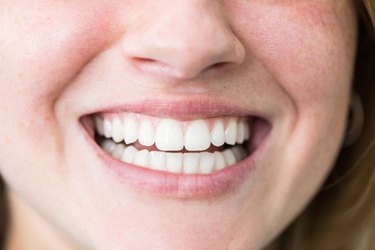
The masseter muscle is responsible for chewing and clenching of the jaw. Masseter muscle exercise can help when these muscles become overworked due to a teeth-grinding or jaw clenching habit. Exercises can help relieve the pain associated with the masseter muscle.
Pain in the temporomandibular joint (TMJ) can occur when you repeatedly clench your jaw or grind your teeth, resulting in what is colloquially called lockjaw, according to the Cleveland Clinic. Lockjaw is actually a temporomandibular disorder (TMD) and can be very painful.
Video of the Day
Video of the Day
Read more: Exercises to Relax Jaw Muscles
What Causes Masseter Muscle Problems?
There are different causes of temporomandibular disorders, according to the Cleveland Clinic:
- Arthritis
- Jaw surgery
- Stress that causes tension in the jaw
- Dislocation in the jaw
- Grinding teeth or jaw clenching
Women experience TMD issues more than men and the most common age for it to arise is 20 to 40 years. Symptoms can include difficulty chewing; popping or clicking in the jaw; pain and tenderness in the jaw, neck and shoulders, head pain; your jaw feeling stuck in place; and the inability to open your mouth fully, among others.
If you experience any of these symptoms, be sure to speak to your health care provider. TMD can cause complications with receiving important dental care, according to the March 2018 issue of the Australian Dental Journal. Approximately 60 to 70 percent of the general population can experience at least one symptom of TMD, but only 10 percent of those people will need to have surgery. There are other strategies to reduce the symptoms of TMD, including masseter muscle exercise.
Read more: How to Strengthen Your Jaw Muscles
Masseter Muscle Exercise
According to the Mayo Clinic, TMJ disorder can go away on its own. If it doesn't, your medical professional can help come up with strategies or treatments to help you. Some of these strategies can include masseter muscle exercises such as stretching and massage.
Some of these exercises may be performed by a physical therapist or given to you to do at home. Kaiser Permanente recommends some simple exercises to do on your own. Below are three to try for an at-home masseter muscle workout:
Move 1: Tongue Rest Position
- With your jaw relaxed and teeth slightly apart, place your tongue on the roof of your mouth in a resting position.
- "Cluck" your tongue while keeping your teeth slightly apart.
- Repeat six times, up to six sessions per day.
Move 2: Controlled Opening
- With your tongue in a resting position at the roof of your mouth, place your index fingers of each hand over your temporomandibular joints.
- Without letting your tongue leave the roof of your mouth, open your jaw as far as you can.
- Check in the mirror for your jaw deviating to one side or the other.
- Try this while chewing, yawning and biting.
- Repeat six times, up to six sessions per day.
Move 3: Head Flexion and Head Extension
- Intertwine your fingers of your hands behind your neck.
- Keeping your head in an upright position, nod your head forward while tucking in your chin.
- Repeat six times, up to six sessions per day.
Other Treatments for TMD
Other treatments for TMD besides masseter muscle exercise, according to a March 2018 issue in the Journal of Pain Research include:
- Oral and topical medications
- Corticosteroid injections
- Surgery
- Dental therapy, including splints
- Physical therapy
- Manual therapy, including trigger point therapy
- Dry needling and acupuncture
- Electrotherapy
- Cognitive-behavioral therapy to reduce stress-related clenching and grinding
- Relaxation and self-management techniques
- Cleveland Clinic: "Stubborn TMJ Pain? Try Trigger Point Massage and Jaw Exercises"
- Cleveland Clinic: "Temporomandibular Disorders (TMD): Overview"
- Australian Dental Journal: "Management of Temporomandibular Joint Disorders: A Surgeon's Perspective"
- Mayo Clinic: "TMJ Disorders"
- Kaiser Permanante: "Exercise Program for Pain and Dysfunction in the Head, Neck and Temporomandibular Joint"
- Journal of Pain Research: "Management of Pain in Patients With Temporomandibular Disorder (TMD): Challenges and Solutions"
- Baltimore Center for Laser Dentistry: TMJ
Is this an emergency? If you are experiencing serious medical symptoms, please see the National Library of Medicine’s list of signs you need emergency medical attention or call 911.